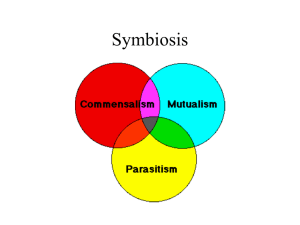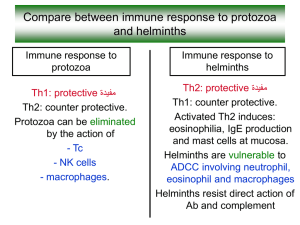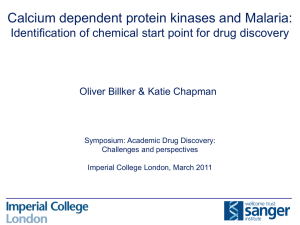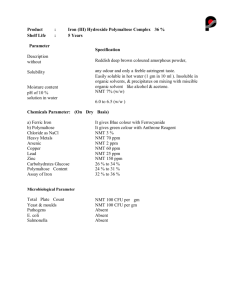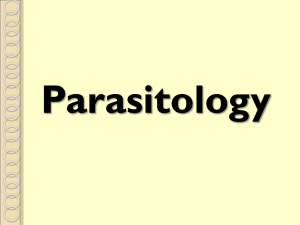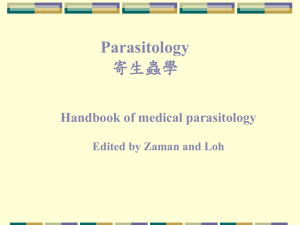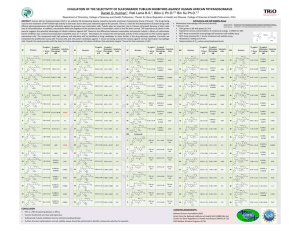Price Horrocks 02-09-14
advertisement
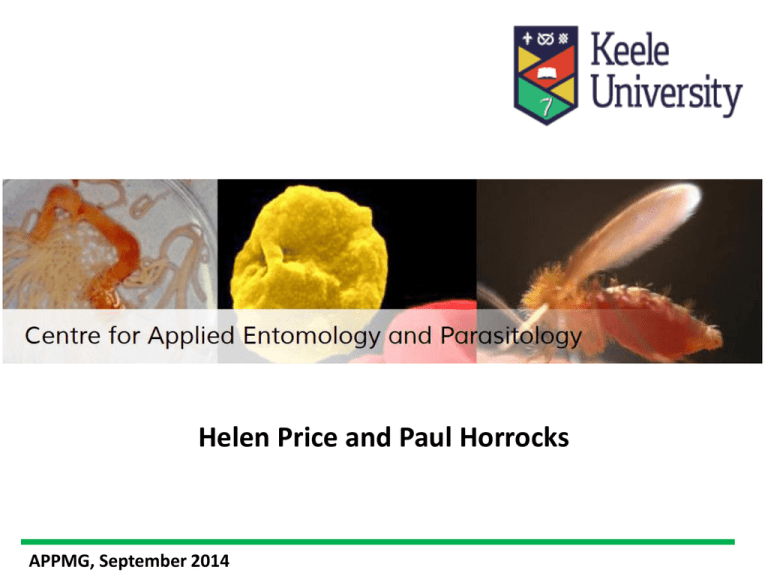
Helen Price and Paul Horrocks APPMG, September 2014 • Delivering Health Research with a focus on insectborne tropical diseases • Delivering Economic Impact • Influencing Policy • Communicating Research • UK / International Collaborations 11 Research Groups (3 Professors, 4 Early Career) Insectaries Aquarium Cat3 cell culture Haldane Multi-User Laboratory Gas/liquid separation and spectrometry Proteomics X-ray crystalography Imaging Radioactive room Olfactory behaviour Field sites. Including Mali and Brazil CAEP - Health Research with a focus on insect-borne tropical diseases Vector Parasite Genetic/epigenetics in gene expression Transgenic mosquitoes refractory to infection Comparative genomics Mosquito fitness and population structure Invasion blocking with sulphated carbohydrates Mosquito olfaction Host Chemical communication in sandflies Antimalarial screening and assay development Antileishmanial drug development The blood-brain-barrier Adhesion to vascular endothelium Antimalarial drug development – screening out the “fast-acting” drugs Paul Horrocks APPMG, September 2014 The challenge…… Small molecule drugs are a critical component of any malaria control policy Currently met using Artemisinin combination therapies. Artemisinins are potent and rapid acting. Artemisinin treatment failure/evolving resistance Demand that we search for novel chemotypes 400 in “Malaria Box” Preclinical 15000 in TCAMs set > 2 million compounds Discovery Clinical Approval Drug Our aim is to help streamline the development process by introducing in vitro assays for pharmacodynamic action in the preclinical stage We hope to impact on time-toclinic and improve cost efficiency of the drug development process Antimalarial drugs: a bioluminescence assay to rapidly estimate rate-of-kill P. falciparum parasite GM parasite – expresses luciferase No drug + drug P. falciparum parasite Add luciferin Add luciferin Bioluminescence • Sensitive and rapid assay format • Excellent signal/noise ratio, minimal background signal • Simple to develop reproducible data • Scalable for high throughput screens Screening the MMV “Malaria Box” lead drug candidates Pre-screening eliminated 100 drugs from the assay as showing no activity within 6hrs of start of treatment Increasing rate of kill Fast-acting drugs in the MMV “Malaria Box” Target Candidate profile 1:‘Fast clearance’, reducing the initial parasite burden “…the expectation is that molecules will have a parasite reduction rate…at least as fast as 4-aminoquinolines, and ideally faster than artemisinin derivatives.” 14 ideal candidates 26 at least as fast as 4AQ. Future work What common (novel) structural features do fast acting drugs share? Adapt the assay to act as a community research tool to provide support for the design of novel antimalarial drugs New therapeutics for kinetoplastid diseases Helen Price APPMG, September 2014 Leishmaniasis and Sleeping Sickness: the challenge • Regions of extreme poverty, poor healthcare, conflict • Animal hosts act as ‘reservoirs’ • Old toxic drugs • Drug resistance • No vaccines Leishmaniasis and Sleeping Sickness: the challenge • Regions of extreme poverty, poor healthcare, conflict • Animal hosts act as ‘reservoirs’ • Old toxic drugs • Drug resistance • No vaccines Original samples of Suramin (Bayer 205) developed in 1916 Challenges for Kinetoplastid Drug Development Trypanosoma brucei • Cross blood-brain barrier in late-stage disease Leishmania • • • • Inside host macrophages Acidic environment 3 membranes to cross Parasites pump drugs out Drug Development Strategies 1. Phenotype-based approach X + Parasite Test compound Parasite death 2. Targeted-based approach X + An essential protein in the parasite Test compound ? ? Inhibits the role of the protein X Parasite death ? NMT Inhibitors as Potential Drugs (1) • Known drug target in fungal pathogens • Essential for survival of T. brucei and L. donovani NMT Enzyme High-throughput screens: • 100,000 compounds - T. brucei NMT + Test compound (Drug Discovery Unit, Dundee) • 150,000 compounds - L. donovani and P. falciparum NMT (Pfizer) NMT Inhibitors as Potential Drugs (2) T. brucei • Potent NMT inhibitors kill parasites in vitro and in mouse model • Unable to cross blood-brain barrier • Repositioning as veterinary drug and anti-cancer therapy (DDU) L. donovani • NMT inhibitors very effective on protein but less potent on parasite Focus on Cutaneous Leishmaniasis (CL) • Cutaneous, mucocutaneous and visceral forms • Cutaneous disease: over 75% of all cases • Toxic drugs versus no treatment • Drug discovery programmes for species causing visceral disease Cutaneous Mucocutaneous Visceral Magnetic nanoparticles to treat CL? • Collaboration with Neil Telling and Clare Hoskins at Keele • Chemical coatings to target nanoparticles to correct cells • Can control heat by strength of magnetic field • Use on multidrug-resistant parasites • May also kill bacterial pathogens • Portability is an issue: development of magnetic bandages and devices at Keele Acknowledgements: Research colleagues at CAEP Prof. Debbie Smith of University of York The following organisations for funding and access to small molecules: Helen Price: h.price@keele.ac.uk, Twitter: @helenpprice Paul Horrocks: p.d.horrocks@keele.ac.uk




